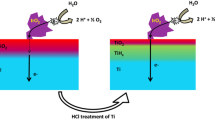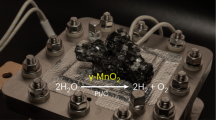Abstract
Aqueous tritium enrichment parameters of a commercially available Iridium/Platinum (Ir/Pt) polymer electrolyte membrane (PEM) cell were determined after electrolysis of tritium aqueous standards, and compared to those of a conventional Nickel/Iron (Ni/Fe) electrochemical cell. Lower aqueous enrichment is seen in the Ir/Pt PEM electrolyzer in comparison to the conventional Ni/Fe electrolytic cell. This is explained by the values found for the PEM cell fractionation factor β Ir/Pt and electrolytic fractionation factor β eIr/Pt values determined to be 4.7 ± 0.3 (β Ni/Fe = 26), and 6.6 ± 0.7 (β eNi/Fe = 37), respectively. A direct consequence of the Ir/Pt β e value is the richer tritium gas phase produced relative to the conventional cell, which is advantageous for direct reduction of HTO to HT gas.



Similar content being viewed by others
References
National Research Council, US Board on Radioactive Waste Management (2000) Research needs in subsurface science. National Academy Press, Washington, DC
United States Department of Energy (1993) Radiation protection of the public and the environment. Order DOE 5400.5. Office of Environment, Safety and Health, Washington, DC
Electronic Code of Federal Regulations (2007) Appendix B, part 20, title 10
United States Environmental Protection Agency (2000) Maximum contaminant level for beta particle and photon radioactivity from manmade radionuclides in community water systems. National primary drinking water regulation 40-CFR-141.16
United States Department of Energy (2000) Groundwater/vadose zone integration project science and technology summary description, DOE/RL-98-48, vol III, revision 3
United States Department of Energy (2001) Hanford science and technology needs statements, DOE/RL 98-01, revision 3
Kaufman S, Libby WF (1954) Phys Rev 93:6
Östlund HG, Werner E (1962) IAEA-SM-13, vol 1, p 95
Cameron JF (1967) IAEA, SM-87/25, p 543
Östlund HG, Dorsey HG (1977) Low radioactivity measurements and applications. In Proceedings of the international conference, p 542
Fritz SJ, Leap DI (1991) Establishment of a mid-continent tritium counting facility for groundwaters. Technical report, Indiana Water Resources Research Center, Purdue University, Indiana
National Council on Radiation Protection and Measurements (1976) Tritium measurement techniques. NCRP report 47, pp 22–25
Taylor CB (1981) IAEA-SM-252/68, p 303
Ivanchuk OM, Goryanina VG, Rozenkevich MB (2000) Atomic Energy 89:3
Jacobs DJ (1968) Sources of tritium and its behavior upon release to the environment. U.S. Atomic Energy Commission/Division of Technical Information. Critical Review Series. TID-24635, Clearinghouse for Federal Scientific and Technical Information, Springfield, VA, p 36
Bockris JOM, Reddy AKN (1970) Modern electrochemistry. An introduction to an interdisciplinary area, vol 2. Plenum Press, New York, pp 1249–1250
Ogata Y, Sakuma Y, Ohtani N, Kotaka M (2005) Fusion Sci Technol 48:136
Acknowledgments
The authors thank the Miami laboratory staff for their assistance in understanding the method used for tritium enrichment of environmental water samples, Dr. Stephen Creager for his assistance with the PEM cell work, and Mr. Ken Dunn for shop work. This work was funded by the Department of Energy under the DOE Environmental Management Science Program # DE-FG02-07ER64411 grant entitled “Radionuclide Sensors for Water Monitoring”.
Author information
Authors and Affiliations
Corresponding author
Rights and permissions
About this article
Cite this article
Soreefan, A.M., DeVol, T.A. Determination of tritium enrichment parameters of a commercially available PEM electrolyzer: a comparison with conventional enrichment electrolysis. J Radioanal Nucl Chem 282, 511–515 (2009). https://doi.org/10.1007/s10967-009-0256-7
Received:
Accepted:
Published:
Issue Date:
DOI: https://doi.org/10.1007/s10967-009-0256-7




